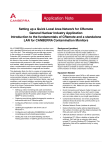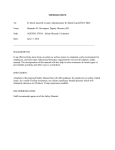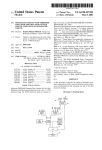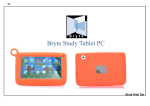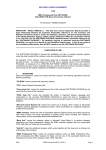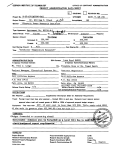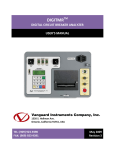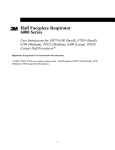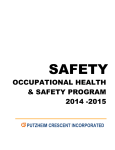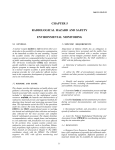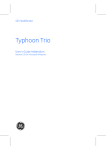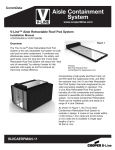Download Radon Progeny Rejection with CANBERRA Argos™
Transcript
Application Note Radon Progeny Rejection with CANBERRA Argos™-5AB Personnel Contamination Monitors Argos-5AB CANBERRA’s personnel contamination monitors, and in particular the ARGOS-5AB gas flow proportional model, are used throughout the world’s nuclear industry. Typically these monitors are designed to detect surface contamination from alpha, beta and gamma emitters (if the gamma option is installed), however, the units also have the capability to “reject” the presence of radon progeny which often plates out on synthetic clothing materials and plastic objects such as polyester clothing, fleece, and hard hats. Activity levels of these progeny have the potential of exceeding the alarm set points for external surface contamination typically set to detect 5000 dpm β /1000 dpm α (83.33 Bq & 16.67 Bq, respectively), thus presenting results which appear to be “Contaminated”, when the alarm indication is due to naturally occurring radioactive materials, and not plant or facility related licensed material. To complicate matters, many plants have set more conservative alarm level settings, sometimes considering the presence of “difficult-to-detect isotopes in the station radionuclide mix” as recommended by INPO. (INPO 05-008). In this application note, the following topics will be covered: • Background of the problem • Method of “rejection” • Guidance and Acceptance Criteria • Argos Monitors and Software • Determination of the Presence of Radon Progeny • Specific Settings • Practical Demonstration Example • Data Collection and Analysis • Summary 1 Background (the radiation and problem) The Basic Method: Radon is a colorless and odorless radioactive gas that is produced by the radioactive decay of radium. Radium is a product of uranium decay and is found in trace amounts naturally in nearly all rocks, soils, and groundwater as well as building materials, plants, animals, and the human body. One of the known characteristics of radon related contamination events is that they are normally very close to release limits (i.e. low activity). Note the radon decay chain shown on the previous page. Note the short lived alpha and beta emitters which are present as radon progeny (Po-218, Pb-214, Bi-214, Po-214) which attach themselves to clothing and objects. The method used by CANBERRA involves the use of the beta to alpha activity over a range of body locations to trigger monitor actions, and settings dependent upon the appropriate selection of the ratio. In selecting this ratio, one must consider several factors to avoid the identification of contamination resulting from plant operations as “radon” related. Typical plants without failed fuel have beta to alpha activity ratios that are in the 100’s of thousands to millions to one. Thus, the typical expected presence of any alpha related activity would not be due to normal plant operation, but most likely from radon related decay products. If sufficient alpha activity is present due to facility conditions/source term, then this method must be used with extreme caution /conservatism, restricted to personnel who are not working in areas of potentially elevated alpha contamination, or not at all. From the decay chain, one might expect a certain fixed beta to alpha particle ratio if this chain was in equilibrium. However, in practice, in air, and particularly on objects, the decay products are not in a set equilibrium. Many factors can affect the measured ratio including: • Attenuation of alpha in air (i.e., distance from the detector). • The type of ventilation system(s). • The concentration of progeny on the monitored object and in the air. • The time elapsed from acquiring radon progeny on clothing to the monitoring point. Applicable Guidance and Acceptance Criteria • The Institute for Nuclear Power Operations (INPO) and the American Nuclear Insurers (ANI) have acknowledged the ability of monitors to identify naturally occurring materials such as radon progeny. For example, INPO states the following: “If the monitor does not have the ability to account for radon, have procedures in place to evaluate alarms for short-lived or natural radioactivity” The problem also arises in that there is no clear way to immediately and positively identify the cause as activity from radon progeny without some type of spectroscopy. While this spectroscopy is practical using very close and constant geometry, as is done using CANBERRA’s iSolo® and iCAM™ products, this method isn’t possible using either gas flow or solid scintillation based alpha/beta detectors due to variable and potentially significant distances (relative to the range of the alpha particle) from the detectors, and the lack of sufficient spectroscopic capabilities of these detectors. • Similarly the American Nuclear Insurers (ANI) notes in ANI Section 8.5 Radiation Protection Bioassay. “The bioassay program should be governed by a set of procedures which describe the following: 8.5.2.7 Methods to determine whether PCM/PM alarms are caused by radon, noble gas, internal contamination, distributed external contamination, or discrete hot particles” and… In a typical nuclear power situation, the personnel (or equipment such as hard hats) which were determined to be contaminated at the RCA exit point and thought to be so from radon progeny, would sit off to the side and wait for the short lived radon progeny to decay. Once decay had occurred, personnel would make additional attempts at passing through the monitors to achieve a “Clean” determination. On days where radon, and thus radon-progeny concentrations may be high, it may not be uncommon to have a handful, or up to a dozen or more personnel (and objects) waiting to “decay” prior to exiting the RCA. “If Radon is determined to be the cause of the alarm, a PCM with Radon (alpha) discrimination capabilities may be used to clear the individual” • EPRI states the following: “Radiation Protection Response to Indicated Contamination If contamination is indicated on a person, the following steps should be taken: …. 4. Determine if contamination is due to short-lived radioactivity (i.e., half life < 2 hours). Such may not be considered a PCE. Refere to the EPRI PCE guideline (EPRI 2005) Many personnel waiting is costly to the utility/facility because personnel are still “on the clock” sometimes collecting overtime pay, as well as stressful/annoying to the employees who cannot leave the RCA for home, meals, or other engagements. In addition, the possibility of true contamination may also be on the workers’ minds. The potentially contaminated personnel, objects/clothing, such as hard-hats, can become a distraction as well as an additional source of unnecessary work/surveys for radiation protection personnel who may already be short-staffed. This is often likely the case “If the monitor does not have the ability to account for radon, have procedures in place to evaluate alarms for short lived or natural radioactivity” (INPO 05-008). Thus, procedures and personnel must be available to deal with radon progeny if an automated system is not available. And… 2 If the suspected contamination is cause by noble gas, radon, or medical radioisotopes, as identified through decay counting, isotopic analysis, worker interview, or knowledge/verification of plant conditions such as leaks or environmental inversions, then the article of clothing may be: • Left in a designated area for decay and may be resurveyd later for release • Decontaminated and returned to the owner • Released based upon isotopic analysis separate smaller detectors or “zones” per large detector. These smaller zones may be configured/combined as virtual detectors as sum zones. The principle behind the use of a sum zone (s) is to be able to detect contamination which may be between detectors in the minimized areas of the frame which has no detector exposed (also known as dead zones). As a consequence of this assumption that the source is between zones, the efficiency is lower, and spread/disperse activity which is characteristic of radon progeny deposition, the sum zones normally tend to alarm more frequently for radon progeny. However, this has been addressed in how the monitor handles such contamination and will be discussed later on in this application note. A number of pictorial representations can be seen in Figures 1, 2, 3, 4, 5 and 6 showing single detector zones, and what different series of a sum zones are comprised of (zones are shown by cross hatching). Grayed out detectors indicate that those detector/ sum-zone combinations are not possible. These sum zones can also be used to determine the beta/alpha ratio present to drive radon rejection actions of the monitor. So guidance exists from industry documents and recommendations acknowledging the problems of radon progeny and methods to deal with these problems using contamination monitors and methods. The Monitor: The ARGOS-5AB as typically configured at many nuclear power facilities includes up to twenty-five (25) gas flow proportional detectors, each detector having three (3) Figure 1- Single Zone Figure 2 Intra Pair Sum-Zone Figure 3 Inter-Pair Figure 4 Inter-Pair Figure 5 Quad Zone Figure 6 Another Quad Zone 3 The Argos Monitor Software Using the keyboard down arrow to the bottom of the menu and highlight the “Radon Rejection Support” and toggle the ± key to set this to “YES”. Press the “ESC” key twice to retain your settings and return to the Service Menu. (Note that your menu may appear different for other settings, as these screen captures have been produced on a demonstration software version of the monitor.) The monitor software includes data collection, results files and archiving capabilities which enable the easy collection of monitoring data related to establishing your beta to alpha ratios for radon progeny rejection or “radon rejection”. It is possible to enable radon rejection in the software and capture data to tune your beta/alpha ratios and settings. Let’s look at the data files present on the Argos monitor and see what radon progeny rejection related data and settings are available. The basic settings are available only if radon progeny rejection is enabled. So from the Service Menu of the monitor (available by using the USB keyboard plugged into the computer of the monitor) press the escape key. Once in the Service Menu, press the CTRL-F10 key combination, this is a “hidden” key combination, which will place you in the Factory Setup Menu, from the Factory Setup Menu, select F1 – Model Selection. Care should be used in this menu, as it is possible to change the monitor type and other configurations that may cause you to lose your original monitor settings. Please see the user’s manual to make sure you have backed up your settings prior to entering this menu. Now that your monitor has been enabled at the Model Selection Level, it is time to proceed to enabling the rejection settings within the Setup Menu. The Setup Menu is selected by pressing “F3” on the Service Menu, then select “F10 – Radon Rejection” to enter the radon progeny rejection setup screen. 4 Note that currently as seen below, while “Enabled” no action is actually taken by the monitor to change any settings “If Radon [progeny are] is Detected (Beta/Alpha Ratio within Limits)”. However, in this “Enabled” state even though no action is being taken, the Monitor starts to collect data in a file called RADON.csv. This file, and the RESULTYYYYMMDDHHMMSS.TXT files will contain the BETA/ALPHA ratios for all Possible changes which might occur, and how/when the changes will be made is determined by several factors. These are described in the following paragraphs. By default the Radon [Progeny] Rejection will be set to the “Disabled” state. Toggle the ± key to enable. When enabled the monitor will come up in the Factory Default settings. 5 How does the monitor determine if Radon Progeny is detected? The monitor then makes the following comparisons: 1. It checks the ratios against the Lo Limit and the High Limit in each of the areas monitored. 2. If the beta/alpha ratio is within the limits specified in the settings (which are 0.6 to 6.0 as seen in figure X below) it sets a “Radon [progeny] Detected” flag to “YES” for those zones. 3. If the beta/alpha ratio is outside the limits (in this case less than 0.6 or greater than 6.0) the “Radon [progeny] Detected” flag gets set to “NO” for those zones. Using the basic premise that we discussed at the beginning of the Application Note, the Monitor software makes this decision based upon the Beta/Alpha Ratio. The Ratio is calculated in one of two ways. One being the “Net Rate” in cps of the Beta/Alpha count rate and the second or the “Activity” being the (beta count rate/efficiency) divided by the (alpha count rate/efficiency). Now that the decision flags have been set, some actions are then taken/or not taken by the Monitor program. SOME TYPICAL SETTINGS AND ACTIONS Many customers find settings for the Beta/Alpha ratio in the 0.6 to 6.0 range to be effective. However, ratios as high as 15 have been used. The following screen captures will progress from the least aggressive to the most aggressive settings to reduce radon progeny false alarms. This is often the way that the radon progeny rejection can be setup in an experimental fashion in real time while individuals whom are known to have radon progeny on them are available for testing. Starting out with the least aggressive settings, and continuing to take steps using settings until an acceptable level of clearance of individuals as “clean” is achieved. Once the settings have been tweaked experimentally, a freshly made representative plant smear should be created and placed on individuals passing through the monitors to ensure that actual contamination does not exit the RCA. The idea is that the plant smear will/should make the beta/alpha ratio high enough so that it exceeds the upper level of the ratio setting. Least Aggressive (1): (Turn off Sum Zones Alarms for just those detectors that have the beta/alpha ratio within the limits from 0.6 to 6.0) Don’t allow Sum Zones to Alarm on “Detectors that show radon [progeny]: So any sum zone which would normally be considered contaminated (nominally 5000 dpm or greater beta or 1000 dpm or greater alpha) would not alarm and would give a “Clean” result. Note that this happens ONLY for SUM-ZONES (combinations of individual detector sections where at least one of the detectors within the sum zone has a Radon Detected flag set to “YES”). A single zone, or single detector section would still be considered contaminated if it were determined to be above 5,000 dpm and 1000 dpm alpha activity or beta activity, respectively. An individual steps into the monitor and is counted on the front side, then turns around and is counted on the back side. After each side’s count is completed the monitor has calculated the beta/alpha ratio for the individual zones, and in the case for settings above, the beta/alpha ratio for the activity in any of the sum-zones (Ratio Sum Zones set to “Enable”) are also considered. 6 More Aggressive (3): Sum Zone Alarms are turned off for only detectors that show radon (ratio within limits), but now the CTP (definitely contaminated) Alarm level is used. Please see the definition of ALS, ATP, CTP and UTP in the Argos manual for further specifics. More Aggressive (2): Don’t allow any of the Sum Zones to alarm if any one (1) detector section, or any one (1) Sum Zone has the correct beta/alpha ratio. For example, if detector section 6a (leg) had a beta/alpha ratio greater than or equal to 0.6 AND less than or equal to 6.0, no sum zone would alarm. Again, single detector sections would still alarm if they were above the alarm set points. More Aggressive (4): 7 More Aggressive (5): Now the Alarm settings use multipliers (Alarm level setting times the multiplier) of 5000 dpm times 2.25 = 11,250 dpm for detectors on the monitor, if that single detector has the beta/alpha limit within the limits. Detectors or SUM Zones which do not have the correct ratio, do not have alarm multipliers applied. The aggressiveness of this approach can be adjusted by the multiplier value. Most Aggressive (6): Now the Alarm settings use multipliers (Alarm level setting times the multiplier) of 5000 dpm times 2.25 = 11,250 dpm for every detector on the monitor, if any single detector or sum zone have the beta/alpha limit within the limits. The aggressiveness of this approach is now limited only by the value of the multiplier. Note: The value of a multiplier can target to the most problematic areas, or left at 1.0 (no effect) for areas where one would not want to increase the alarm level setpoint. 8 Final Safety Fallback: So you ask. Where is your ultimate safety fall back position on this? The answer is in enabling the High Contamination Alarm in the Common Values Section (F1 from the Setup menu) and its associated High Activity Limit set globally for the monitor in the Global Setting (F3, Shift+F5 from the Setup Menu, and then Alt+1 for beta, Alt+2 for alpha). All the potential actions by the Radon Progeny Rejection are overridden if the contamination level exceeds the levels set. This value is set at 22,200 dpm times the efficiency value of the detector for beta, or alpha, respectively. For a nominal efficiency value of 10 % the High Contamination Alarm would be triggered at a net count rate of 2,220 net cps. The level can be set differently for various areas (foot, top of shoe, body, head, and hand) by using the F5 Group Settings. 9 A PRACTICAL DEMONSTRATION As seen on the Monitor program: The easiest way to demonstrate how this all works in practice is to use some actual preliminary files/settings from a monitor at a facility with significant radon progeny levels. At this facility, the beta activity levels on some clothing (polyester blend pants) and hardhats were in excess of 15,000 dpm as reported by the monitor. The typical alarm level settings for this facility are as follows: Alarm Level settings: 1. Beta: 4500 dpm (4p) 2. Alpha: 1000 dpm (4p) Radon Progeny Rejection settings as seen below can be seen in the SETUP.TXT file and a screen capture from the Monitor program. Note that you would typically not use both the CTP and multipliers at the same time, as the monitor determines the CTP first and then applies the multiplier value. More exact control can be achieved by adjusting the multiplier alone and not use both the CTP and multipliers combined: The “Contaminated Screen” bitmap generated from an individual with radon progeny on them is generated when a contaminated result is found: SETUP.TXT File: 10 The ratios are calculated for the individual detector zones, detector 5 (a “leg” detector) for example has three sections 5a, 5b and 5c. The beta/alpha ratio is calculated for each single zone. In addition, detector 5 also has SUM ZONES associated with it (we will just consider single detector section zones for the purpose of illustration) these are intrapairs 5a-5b and 5b-5c. When we look at a RESULT.TXT file for the front side (denoted by a “P1 C” suffix on the file to denote that the result was contaminated “C” and the front side position 1 “P1”) (Figure below) we can see the beta/ alpha ratio for these detectors. For detector 5c the “Radon Ratio” is 4.3 which is in between 0.6 and 9.0 beta/alpha ratio. Thus Radon Detected = Yes in the header of the file. Thus the monitor has taken the following actions. If “radon” was detected the Alarm level was multiplied by 2.25 so we see the Alarm of 75 Bq times 2.25 is now set at 168.8 Bq. Also, in this case CTP will be used instead of CTP so the CTP for this new Alarm Level is 180.5 Bq. This has been set on detectors in the Body section. Note however that the multiplier for the Foot is set at 1.0, so the Alarm setting is unchanged. However, since we are using CTP instead of ATP on “All Detectors if Any Show Radon” the Used Trip Point for the Alarm is set at the value for CTP. Thus all the actions that were to be taken were applied. 11 While the radon progeny rejection worked for these detectors, still several detectors were considered contaminated, and likely were due to radon progeny. So why weren’t these detectors caught by the radon progeny rejection? Let’s have a look at detector 16a on the front of the body which can be seen in the “Contaminated” image at being at 6,706 dpm. If we look for detector 16a in the RESULT.TXT file we see the following: No radon ratio (no beta/alpha ratio was found). When no ratio is present, radon progeny flag is set to NO, and the proper ratio does not exist according to the monitor. Thus, per the setup, multipliers were only to be used on “Detectors that show radon”, since the beta/alpha ratios were zero. No multiplier was applied. However, since the CTP was to be used across the entire monitor Use CTP instead of ATP on All detectors if any show radon. But the CTP of 10.1 was just 0.7 cps below the actual net count rate of 10.8, and thus the result was considered to be “contaminated”. 12 Practical Determination of the Beta to Alpha Ratio Here a RADON.CSV file has been copied from the DATALOG folder of an Argos-5AB Monitor. Note that for all contaminated results a corresponding data and time stamped entry will also be made in the CONTAM.CSV file. These are results extracted for a single individual who was determined to have radon progeny on the legs of his pants in zone 9 and zone 16 (these zones correlate to detector sections 3c and 6a as seen in the zone pictorial below). Only the data from zone 9 is displayed in the Excel sheets. Determination of the Beta to Alpha ratio can be achieved by analyzing the results of the RESULT.TXT files, however this is time consuming when many files need to be evaluated. Once radon progeny rejection has been enabled on the monitor, the monitor will collect the beta/alpha ratio data for each and every zone of the monitor, for every individual monitored in the RADON.CSV file. The Radon Detected flag may be NO in these trials since you are collecting data to determine the beta/alpha ratio, and if the ratio does not agree with your settings, then the NO flag will be set. CONTAM.CSV RADON.CSV 13 Once all the data associated with the collection of volunteer personnel is collected, the RADON.CSV file can be analyzed by body area and the average ratio’s selected. Various analyses may be performed to determine the averages, ranges, and most appropriate ratios to be selected for trial in the monitors. 14 Collection and Analysis of data: Setting up to perform and document the collection of radon progeny data by considering the inclusion of the following elements: • Outline a test plan and the steps needed to complete the testing. Determine a location within your facility that you have identified as a source of radon progeny, and the absence of licensed material. • Configure the monitor so it is ready to collect data. Make sure all monitors are operational and have recently passed their routine performance /alarm testing successfully. • Have a recently prepared representative plant smear to test that the radon progeny rejection settings do not pass personnel with a plant smear on them as “Clean”. This is needed to validate the radon progeny rejection settings. Prepare a representative plant smear using methods outlined in the most recent INPO How To, RP 1-4 documents available on the INPO web site. • Have volunteer personnel wear clothing materials such as micro fleece, plastic hardhats, and polyester/ synthetic blend materials. If you have identified problem clothing, make sure to include this in the testing. • Challenge the response and performance of the Monitor in the presence of Radon Progeny only, Radon Progeny plus a representative plant smear, and the performance of the monitor with Radon Progeny rejection enabled, and disabled. • Consider the use of some “control” personnel who DO NOT wear materials which accumulate radon progeny. • Determine your acceptance criteria for overall performance. Does the radon rejection setting identify actual contamination at an acceptable level in the presence of radon progeny? Does the monitor perform acceptably in the absence of radon progeny with radon progeny rejection enabled? The monitor should pass the INPO How To, RP 1-4 at 90% or better in the absence of radon progeny, and ideally at the same rate with radon progeny present. Determine the rate at which you will consider the rejection settings successful with significant radon progeny present. Will greater than 80% be successful? • Monitor all personnel in an Argos unit and get a “clean” determination on each individual prior to putting them into the area of radon progeny. It is possible for personnel to have radon progeny on them from their home environment which may still be present on their clothing depending upon the levels at home, and the time it takes them to travel from home to work. • After the data has been collected and analyzed and the monitors have been setup for radon progeny rejection, send personnel back through the monitors after accumulating radon progeny, to judge the efficiency of the rejection settings. Some typical reductions in radon related alarms range from approximately 60 to 75 %. Define an acceptance criteria goal for reduction of alarms. Determine how “aggressive” you can be in reducing radon progeny alarms. This will depend upon the range and the severity of your radon problem. Consult the User Manual and the CANBERRA Services and Application Support Group (ASG) for assistance or services to complete testing. 15 Summary CANBERRA’s radon progeny rejection algorithm has been demonstrated to significantly reduce the number of false alarms due to radon progeny when correctly implemented. Reduction of these alarms also results in major productivity improvements enabling the radiological protection staff to focus on true contamination events without the distraction of false alarms and management of personnel with radon progeny related alarms. Please contact your sales representative to learn how the radon progeny rejection algorithm can be implemented in your facility and obtain customer references. References 1. Institute of Nuclear Power Operations (INPO) INPO 05-008 Guidelines for Radiological Protection at Nuclear Power Stations (2005). 2. American Nuclear Insurers (ANI) ANI Section 8.5 Radiation Protection Bioassay. (2008). 3. Argos-3/-5 Whole Body Surface Contamination Monitors, User’s Manual, Canberra Industries (2010). Agos is a trademark of CANBERRA Co. iCAM is a trademark of Canberra UK Ltd. iSolo is a registered trademark of Canberra Industries, Inc. Measurement Solutions for Nuclear Safety and Security CANBERRA is the Nuclear Measurements Business Unit of AREVA n For more information please visit: www.canberra.com C39338 - 9/12 16
















